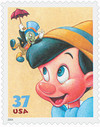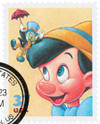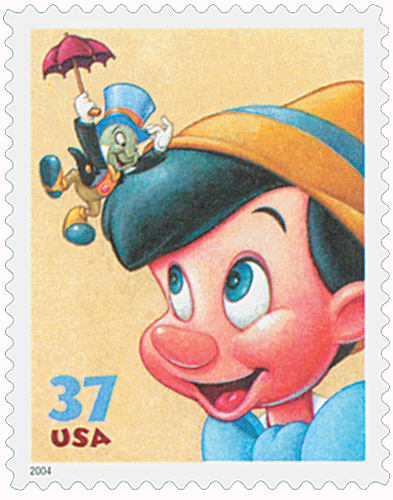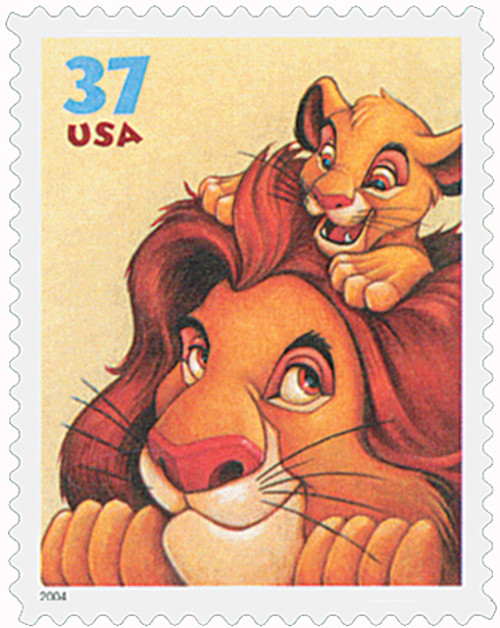
# 3868 - 2004 37c Disney Characters: Jiminy Cricket and Pinocchio
2004 37¢ Pinocchio and Jiminy Cricket
The Art of Disney
City: Anaheim, CA
Quantity: 284,000,000
Pinocchio Premiers
Written in 1881 by Carlo Collodi, The Adventures of Pinocchio is a children’s book about the mishaps of a mischievous puppet that longs to become a human boy. It was published at a time when children’s books were relatively new, so it became popular around the world.
In September 1937, while working on Snow White, animator Norman Ferguson brought an English version of the book to Walt Disney. Walt loved it and planned to produce it as the company’s third movie. It was later moved up to become his second movie when production on Bambi proved troublesome.
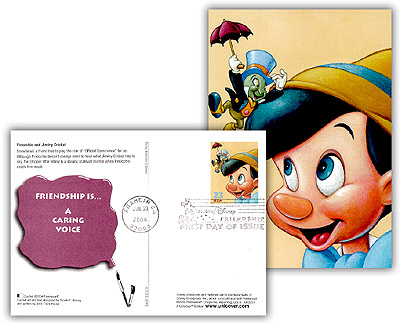
Snow White had been so successful and profitable Disney felt compelled to go all out and make Pinocchio just right. The secret to Pinocchio’s perfection was extensive use of the horizontal multi-plane camera. Disney, and other studios too, had developed the camera over a number of years, getting the technology down in time to shoot a couple of scenes for Snow White. The Disney team perfected their techniques while shooting the 1939 cartoon Donald’s Lucky Day, and went on to use its capabilities to the fullest in Pinocchio.
The multi-plane camera revolutionized Disney’s animation, giving three-dimensional depth to one-dimensional pictures. Imagine a series of seven moveable panes of glass stacked underneath a camera. Now place drawings on each pane of glass. Put a drawing of a puppet on the pane of glass closest to the camera, a drawing of Honest John Foulfellow on the one beneath it, a picture of a dog crossing the street on the one after that, a building down the street on the next, and so on, spacing the drawings according to perspective. Now picture those layers of glass moving, some in unison with the movement of other panes, some moving independently of the other panes, as the camera moves forward and backward, filming through all seven panes of glass.
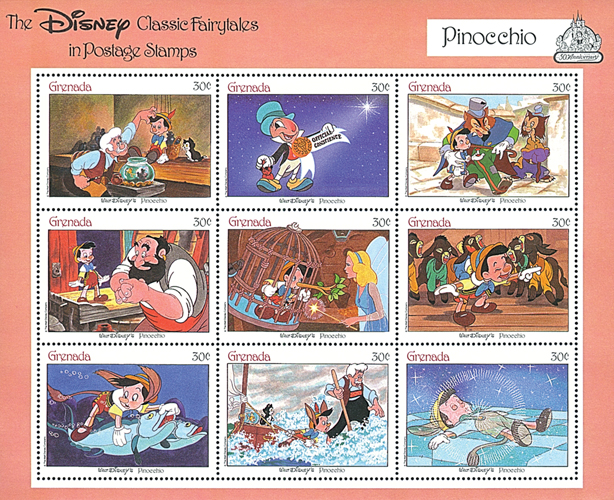
The most outstanding example of the multi-plane capabilities – and probably the most complex scene to shoot – was the scene in which Pinocchio is trapped in a cage inside Stromboli’s wagon. The wagon is moving and Pinocchio is moving inside the swinging cage. Light from the moon high in the night sky beams through the window and the light rays of the Blue Fairy permeate the entire scene!
Understandably, this kind of photography was very expensive. A one-, two-, or three-second scene cost $25,000 to film – a staggering sum today, and even more so in 1939. Not surprisingly, Pinocchio was one of the most expensive features Disney ever made, costing $2,289,000. And to make matters worse for the studio, Disney’s European market evaporated just before Pinocchio’s release. Europe, in the throes of World War II, accounted for 45 percent of the company’s revenues, so Pinocchio was in financial trouble before it was released.
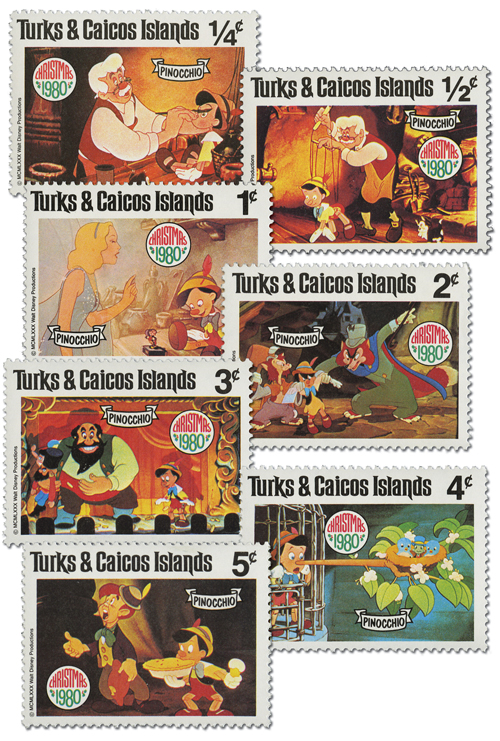
But Walt wouldn’t be deterred from releasing his masterpiece, and it premiered on February 7, 1940, at New York City’s Center Theatre. Pinocchio garnered largely popular reviews. Critic Archer Winsten described the film as “fantastically delightful, absolutely perfect, and a work of pure, unadulterated genius.” However, the loss of international sales due to the war in Europe forced Disney to write off a loss of one million dollars after its initial release. Since then, of course, Pinocchio has earned back this sum many times over.
Pinocchio also received the Academy Award for Best Song (for “When You Wish Upon A Star”) and Best Scoring of a Musical Picture. The moving song, performed by the character Jiminy Cricket, went on to become the Walt Disney Company’s signature song.
Click here to see a neat advertisement announcing the movie’s premiere.
2004 37¢ Pinocchio and Jiminy Cricket
The Art of Disney
City: Anaheim, CA
Quantity: 284,000,000
Pinocchio Premiers
Written in 1881 by Carlo Collodi, The Adventures of Pinocchio is a children’s book about the mishaps of a mischievous puppet that longs to become a human boy. It was published at a time when children’s books were relatively new, so it became popular around the world.
In September 1937, while working on Snow White, animator Norman Ferguson brought an English version of the book to Walt Disney. Walt loved it and planned to produce it as the company’s third movie. It was later moved up to become his second movie when production on Bambi proved troublesome.

Snow White had been so successful and profitable Disney felt compelled to go all out and make Pinocchio just right. The secret to Pinocchio’s perfection was extensive use of the horizontal multi-plane camera. Disney, and other studios too, had developed the camera over a number of years, getting the technology down in time to shoot a couple of scenes for Snow White. The Disney team perfected their techniques while shooting the 1939 cartoon Donald’s Lucky Day, and went on to use its capabilities to the fullest in Pinocchio.
The multi-plane camera revolutionized Disney’s animation, giving three-dimensional depth to one-dimensional pictures. Imagine a series of seven moveable panes of glass stacked underneath a camera. Now place drawings on each pane of glass. Put a drawing of a puppet on the pane of glass closest to the camera, a drawing of Honest John Foulfellow on the one beneath it, a picture of a dog crossing the street on the one after that, a building down the street on the next, and so on, spacing the drawings according to perspective. Now picture those layers of glass moving, some in unison with the movement of other panes, some moving independently of the other panes, as the camera moves forward and backward, filming through all seven panes of glass.

The most outstanding example of the multi-plane capabilities – and probably the most complex scene to shoot – was the scene in which Pinocchio is trapped in a cage inside Stromboli’s wagon. The wagon is moving and Pinocchio is moving inside the swinging cage. Light from the moon high in the night sky beams through the window and the light rays of the Blue Fairy permeate the entire scene!
Understandably, this kind of photography was very expensive. A one-, two-, or three-second scene cost $25,000 to film – a staggering sum today, and even more so in 1939. Not surprisingly, Pinocchio was one of the most expensive features Disney ever made, costing $2,289,000. And to make matters worse for the studio, Disney’s European market evaporated just before Pinocchio’s release. Europe, in the throes of World War II, accounted for 45 percent of the company’s revenues, so Pinocchio was in financial trouble before it was released.

But Walt wouldn’t be deterred from releasing his masterpiece, and it premiered on February 7, 1940, at New York City’s Center Theatre. Pinocchio garnered largely popular reviews. Critic Archer Winsten described the film as “fantastically delightful, absolutely perfect, and a work of pure, unadulterated genius.” However, the loss of international sales due to the war in Europe forced Disney to write off a loss of one million dollars after its initial release. Since then, of course, Pinocchio has earned back this sum many times over.
Pinocchio also received the Academy Award for Best Song (for “When You Wish Upon A Star”) and Best Scoring of a Musical Picture. The moving song, performed by the character Jiminy Cricket, went on to become the Walt Disney Company’s signature song.
Click here to see a neat advertisement announcing the movie’s premiere.



